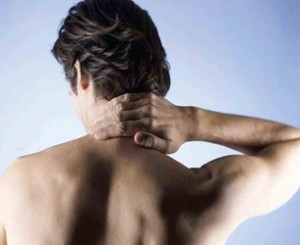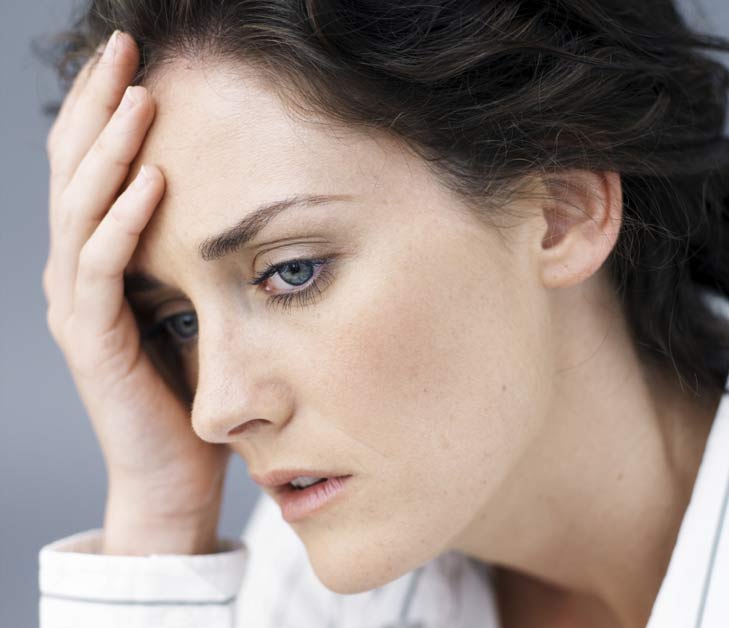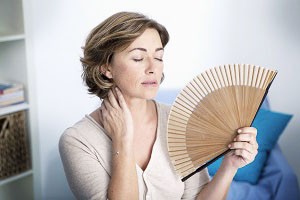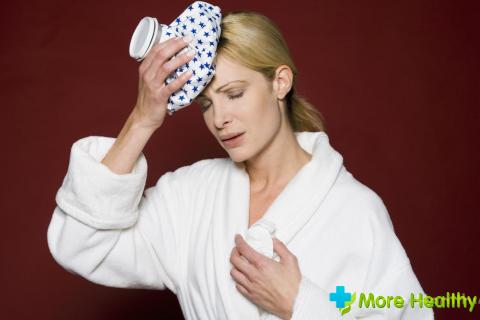There is probably no person who has not experienced a headache at least once. Subjective perception of the nature of headache and its intensity varies among people. That is why diagnosis and treatment methods are determined purely individually for each patient. After all, this symptom is inherent in many diseases:
- pathological processes and diseases of the spine;
- processes affecting the vascular system of the brain;
- circulatory system of the whole body;
- inflammatory processes of the meninges;
- malignant neoplasms;
- infectious and many other diseases (more than forty).
Often in such cases headache accompanied by elevated temperature (from 37 degrees and above).
Headache and low-grade fever (37 – 38C)
The causes of headaches and fever can be infectious or non-infectious. Let's look at some of them.
Non-infectious causes.
Thermoneurosis.
In one of the brain structures, the hypothalamus, there is a center responsible for thermoregulation. human body. During normal operation, body temperature healthy person should not exceed 37 degrees. If for any reason the work of the center fails, thermoneurosis develops. In this case, the body temperature can range from 37 to 38 degrees, which is accompanied by a headache, and last more than two weeks. Objective causes such as inflammatory diseases, endocrine system disorders, injuries and infections may be completely absent.
It is interesting that this phenomenon is characteristic of young people who are uncommunicative and vulnerable, with a melancholic temperament. Will help solve the problem:
- acupuncture;
- hypnosis;
- auto-training;
- hardening;
- adherence to sleep and wakefulness;
- proper nutrition and sleep.
Treatment and taking medications only under the supervision of a doctor.
Tumor processes
If you have a headache, check frequent dizziness, hyperthermia in the range of 37 - 38 degrees for more than a month, while feeling weak, lack of appetite, the person is progressively losing weight - you need to consult an oncologist. The reason for this condition may be:
- Leukemia;
- Vascular disorders in the vertebral-basilar arteries;
- Tumor processes in the kidneys;
- Formations in the liver and lungs;
- Tumor processes in the brain, both malignant and benign.
Intoxication
The entry of various toxic compounds into the body from outside, the presence of viral or bacterial infections in the body can cause acute intoxication.
The symptoms are characteristic and very pronounced: headache, accompanied by a temperature above 37 degrees, chills, nausea and vomiting. After vomiting, the condition improves somewhat.
But if attacks of vomiting are repeated many times, and the victim falls into a stupor or unconscious state, it is necessary to lay him on his side so that the vomit does not interfere with breathing. If you cannot prevent dehydration by taking small sips of liquid, you must call emergency medical help.
Chronic intoxication can often be a manifestation of liver or kidney failure. If headache attacks do not go away after vomiting, this may be an indicator of organic tissue damage. nervous system, tumor processes in the brain, the presence of inflammatory diseases or infections.
Hypertonic disease
 Pulsating, bursting pain in the back of the head, often occurring in the morning, is a frequent herald of persistent arterial hypertension. Cephalgia is accompanied by weakness, slight chills with subfebrile (37 - 38 C) temperature, a feeling of heaviness in the head, dizziness and palpitations. Quite often, the condition is alleviated after a sudden, without nausea, attack of vomiting.
Pulsating, bursting pain in the back of the head, often occurring in the morning, is a frequent herald of persistent arterial hypertension. Cephalgia is accompanied by weakness, slight chills with subfebrile (37 - 38 C) temperature, a feeling of heaviness in the head, dizziness and palpitations. Quite often, the condition is alleviated after a sudden, without nausea, attack of vomiting.
Many people experience atherosclerotic changes in blood vessels with age (the reason for this is refined food, poor in fiber and organic acids, a sedentary lifestyle, drinking alcohol and smoking): they narrow due to the deposition of fatty plaques. In this case, blood stops flowing in sufficient quantities to vital organs, and to compensate for the lack of oxygen and nutrients, the body is “forced” to increase blood pressure in the arteries.
If the above symptoms occur for the first time, then calling a doctor or ambulance is mandatory. If you have encountered this phenomenon before, then you urgently need to take the medications previously prescribed by your doctor and control your blood pressure after 25-30 minutes. You will definitely need to visit a doctor soon.
Many women have experienced the phenomenon of painful menstruation. (dysmenorrhea). It represents a pathology of the cyclic process during menstruation, when pain in the lower abdomen is unbearable.
Pronounced symptoms:
- general weakness;
- nausea and vomiting;
- dizziness;
- headache;
- salivation;
- chills, then cold, then heat;
- temperature ranges from 37 to 38 degrees
Why do such conditions arise? Only a doctor can determine the cause.
To relieve pain, symptomatic drugs are prescribed - analgesics, NSAIDs, and if a diagnosis of menstrual migraine is established - triptan drugs.
A condition where a headache and fever develops is also possible with certain pathologies of the spine, with impaired blood circulation in the muscles and destruction of the intervertebral discs. This happens with myogelosis and osteochondrosis of the cervical spine.
Myogelosis occurs due to painful compactions in the neck muscles caused by poor circulation. The result is a headache in the occipital region, accompanied by dizziness.
Changes in the structure of the intervertebral discs cause cervical osteochondrosis. In itself, an increase in temperature, even as insignificant as 37 degrees, is not typical for cervical osteochondrosis. Changes in the structure of intervertebral discs lead to compression of nerve endings and spinal cord, and this is called spinal stenosis - a consequence of complications of osteochondrosis.
The symptoms are similar and pronounced:
- severe dizziness;
- nausea and vomiting;
- temporary loss of consciousness;
- increased headaches;
- development of cervical migraine.
The method of treatment will be determined by the doctor. Well, you can alleviate the condition by leading correct image life, giving up bad habits. Do not overcool, do not be in drafts, spend as much time in the fresh air as possible and do gymnastics several times a day, the exercises of which are also determined by the doctor individually for each patient.
Infectious causes
Both high and low-grade fever with headaches can occur in diseases caused by infections.
 Acute adnexitis (inflammation of the fallopian tubes and ovaries).
Acute adnexitis (inflammation of the fallopian tubes and ovaries).
The cause of the disease is infections caused by streptococcus, gonococcus, staphylococcus and E. coli, which enter the body in different ways. Microorganisms that cause adnexitis are constant companions of the female body and are activated only when immunity is reduced, for one reason or another. The trigger mechanism for the development of the disease is any intrauterine intervention - abortion, childbirth, examination of the uterus and fallopian tubes, curettage. Symptoms are similar to colds:
- fever, chills and dizziness;
- weakness and malaise;
- nausea and vomiting;
- headache and lower abdomen hurt;
- pain can radiate to the lumbar region and rectum
- irritability, nervousness, insomnia and depression appear.
In acute cases of the disease, the help of a doctor is necessary. You should not take painkillers on your own. This may change the clinical picture and make diagnosis difficult, which can lead to complications. It is important to identify the cause. Why did the development of the disease become possible? Cold (be sure to wrap an ice pack in a towel(!)) applied to the suprapubic area will help relieve the pain.
Flu
 In most cases, when you have a headache and the course of the disease is accompanied by a high or elevated temperature of 37 -37.5, there is every reason to believe that it is caused by an infection.
In most cases, when you have a headache and the course of the disease is accompanied by a high or elevated temperature of 37 -37.5, there is every reason to believe that it is caused by an infection.
In winter, these are various respiratory viral infections, including influenza. It must be remembered that catarrhal manifestations (soreness in the throat and runny nose) are not typical for him in the first days, but very severe symptoms come to the fore. general health. But if, against the background of fever, severe and bursting headaches are accompanied by nausea and vomiting, the muscles of the back of the head are tense, and the patient’s condition quickly worsens, then meningitis can be suspected.
If headaches with fever are combined with nausea and vomiting, urgent hospitalization of the patient is necessary.
A new type of infection is stomach flu.
The most pronounced symptoms are:
- diarrhea;
- nausea and vomiting;
- severe pain in the abdominal area;
- fever and chills;
Infection occurs through contact, through a virus carrier or through contaminated products and drinking water. It is not dangerous for a healthy person, but for older people and children it can be deadly. An effective remedy there is no treatment. Pay as much attention to prevention as possible. Do not drink raw water from unknown sources. Wash your hands frequently and thoroughly with soap and water.
Encephalitis
Encephalitis, like many infectious diseases, manifests itself with certain symptoms, depending on various factors: the pathogen, the course and location of the disease. Manifests: 
- intestinal dysfunction;
- fever and chills;
- headache, nausea and vomiting;
- epileptic seizures;
- psychomotor agitation;;
- fever and dizziness.
The causes of diseases are different. Due to the similarity of symptoms, self-diagnosis can lead to irreversible consequences. Therefore, do not self-medicate, entrust your life and the lives of people close to you to a specialist.
Perhaps each of us is familiar with the unpleasant painful sensation of cold and trembling, especially when a headache and chills occur at the same time. Often such symptoms appear together with weakness and fever. What causes unpleasant manifestations, and what to do in such cases?
Chills are the internal sensation of freezing, regardless of weather conditions outside the window. The duration of this condition can range from several hours to several days in a row and is accompanied by trembling of the whole body, pallor of the skin, and weakness. Most common reasons are:

If a person freezes even in the heat, it means that thermoregulation in the body, for which the thyroid gland is responsible, is impaired. In this case, the tendency to colds increases, brittle hair and dry skin are observed.
- Diabetes . Hypoglycemic conditions in diabetes mellitus are usually accompanied by sensations of hot and cold that occur alternately.
- Thermoneurosis – one of the forms of vegetative-vascular dystonia, in which the symptoms are similar to ARVI syndromes: heat, “goose bumps” and pain in the head are felt almost constantly. However, further development of the disease does not occur. This condition is characteristic of excessive emotional person with psychological problems.
A change in the state of the body in the form of a painful sensation of cold can be provoked by other factors:
- heat stroke;
- painful shock due to organ damage;
- changes in blood pressure.
In women carrying a child, chills are a common occurrence. This is due to increased production progesterone. Some experts consider it normal for febrile conditions to occur during the first 8 weeks of pregnancy.
Emergency measures
At the first manifestations of internal cold and pain symptoms in the head You should not immediately use medications. If the headache is tolerable and there is no strong fever, you can try to improve your well-being with simple recommendations.
Treatment
Treatment of trembling sensations and painful syndromes caused by dangerous diseases, is carried out in a hospital setting using modern medical equipment  equipment In case of intoxication or carbon monoxide poisoning, intravenous infusion of medications is used to neutralize poisonous and toxic substances.
equipment In case of intoxication or carbon monoxide poisoning, intravenous infusion of medications is used to neutralize poisonous and toxic substances.
To detect the causes that provoked the appearance of a febrile state, it is necessary to conduct an examination of the entire body for the presence of diseases. Therapy is carried out based on diagnostic results.
Medications
- If a headache or chills appear as a result of a cold, the doctor will prescribe medications that have an analgesic and antipyretic effect, for example, Antigrippin, Rinza, Rinzasip.
- To eliminate pain, joint aches and fever, it is recommended to take paracetamol, to relieve nasal congestion and runny nose, use the drug phenylephrine. The caffeine contained in the drug reduces drowsiness that occurs with a painful sensation of cold.
- If you have meningitis, you should not self-medicate. If you suspect a disease, you should immediately consult a doctor.
- Women during menopause may be prescribed hormonal medications to relieve feverish sensations.
- For infectious and viral diseases of the respiratory system, antibiotics are prescribed.
- If vegetative-vascular dystonia is diagnosed, treatment should be comprehensive and aimed at strengthening not only the blood vessels, but also the general condition of the body.
A clear sign of vegetative-vascular dystonia is seasickness or motion sickness in transport. There is also intolerance to bright light, accompanied by a sharp deterioration in mood, a feeling of helplessness, as well as feeling close to fainting.

ethnoscience

Experts recommend treating not the symptoms of emerging febrile conditions, but their cause. Most often, painful trembling appears as a consequence of some disease. In order not to provoke the occurrence of infectious diseases, it is necessary:
If you are worried about frequent feverish tremors and pain syndromes in the head, and there is also a suspicion of serious illness, you should be examined by a specialist.
High temperature and headache are a signal that some chronic disease has worsened in the body or inflammation has begun. Each person has their own understanding of the intensity of a headache and its localization. It is often impossible to determine the cause of pain without medical help. Therefore, if the temperature does not decrease and the headache does not stop, you should immediately consult a doctor.
Timely diagnosis will allow you to choose a treatment method exclusively individual for each patient. After all, this symptom is characteristic of many ailments:
- diseases of the spinal column;
- constriction of blood vessels in the brain;
- disruption of the circulatory system;
- inflammation of the lining of the brain;
- infectious diseases, etc.
Regardless of the cause, body temperature rises against the background of a headache. It can be either subfebrile - 37-38 ° C, or slightly elevated.
You should know that an increase in temperature can cause concern both in infectious and non-infectious diseases.
Frequent headaches accompanied by low-grade fever can be caused by infectious diseases.
1. Adnexitis
The root causes of the inflammatory process in fallopian tubes and ovaries are various microorganisms that penetrate the body. All infections that cause adnexitis (streptococcal, gonococcal, staphylococcal, etc.) are constantly present in a woman’s body, but they begin to act actively only when weakened immune system. The signs of adnexitis are similar to the symptoms of a cold:
- heat;
- dizziness and chills;
- general fatigue;
- gagging;
- pain in the head and lower abdomen, which radiates to the rectum and lower back;
- manifestation of nervousness, depression, sleep disturbance.
The acute form of the disease requires immediate drug treatment. However, taking painkillers without a doctor's prescription should be avoided. In such cases, a cold compress (an ice pack wrapped in a towel) applied to the supra-frontal part of the head helps relieve pain.
2. Flu
Incubation period This disease lasts 1-5 days. The main symptoms of the flu are malaise, muscle pain, trembling, headache in the forehead and high fever. If the disease is severe, the headache is very severe, nausea appears, and hallucinations are possible.
In such cases, the patient requires hospitalization.
An infection such as stomach flu can enter the body through contaminated water or food. Its manifestation is characterized by the following symptoms:
- carrying;
- vomiting and nausea;
- sharp pain in the abdomen;
- high temperature, when the patient feels either hot or cold.
To prevent the disease, you should avoid drinking raw water and wash your hands as often as possible.
3. Sinusitis
If you have a headache and fever, this may be the case. When the maxillary sinuses become inflamed, pus becomes clogged in the nasal cavity, and the mucous membrane swells. The main symptoms are as follows:
- general weakness, chills;
- elevated temperature;
- sinus congestion;
- sneezing and mucopurulent discharge from the nose.
Many factors can cause this disease, so a visit to the doctor should not be delayed.
4. Encephalitis
Determining the cause of brain inflammation (encephalitis) is quite difficult. Its symptoms, like those of other diseases of infectious origin, are determined by the form of the course and localization of the disease. The main signs of brain damage are:
- functional bowel disorders;
- heat;
- headache;
- gagging, nausea;
- epileptic seizures;
- nervousness.
The causes of the disease are difficult to establish, but encephalitis must be diagnosed as soon as possible. Self-medication is strictly prohibited.
Non-infectious causes
1. Violation of thermoregulation
 When there is a malfunction in the autonomic nervous system, the blood vessels in the skin begin to spasm. Problems arise in the subcortex of the brain, which is responsible for the body’s ability to maintain temperature within established limits. A healthy person's body temperature should not exceed 37°C. If the center responsible for temperature regulation begins to work incorrectly, thermoneurosis begins. In such cases, the temperature stays within 37-38 degrees for more than ten days.
When there is a malfunction in the autonomic nervous system, the blood vessels in the skin begin to spasm. Problems arise in the subcortex of the brain, which is responsible for the body’s ability to maintain temperature within established limits. A healthy person's body temperature should not exceed 37°C. If the center responsible for temperature regulation begins to work incorrectly, thermoneurosis begins. In such cases, the temperature stays within 37-38 degrees for more than ten days.
The following methods can solve the problem of thermoregulation disorders:
- acupuncture;
- the influence of a hypnotist;
- autogenic training;
- hardening procedures;
- healthy sleep;
- balanced diet.
The entire treatment process, as well as the use of medications, require medical supervision.
2. Neoplasms
Prolonged headache, accompanied by dizziness and a rise in temperature to 37-38 ° C, which has associated symptoms such as loss of appetite, weight loss and general fatigue, may indicate an oncological disease, in particular:
- leukemia;
- vertebrobasilar insufficiency;
- neoplasms in the genitourinary system;
- tumor processes in the liver and lung tissues;
A visit to an oncologist can confirm or exclude a terrible diagnosis.
3. Poisoning
With acute intoxication of the body by viruses and bacteria of various origins, a headache appears, the temperature rises, the patient often shudders, feels nauseous, and vomits, after which the patient feels a little better.
However, if vomiting is too frequent and the patient loses consciousness during it, care must be taken to ensure that the person lies on his side. In this position, vomit will not interfere with breathing. To avoid dehydration, you need to give a patient whose body is affected by toxic substances to drink a lot.
Chronic intoxication can be caused by impaired liver or kidney function. If the pain in the head does not stop, this may be evidence that the tissues of the nervous system are affected, and tumor or inflammatory processes are beginning.
4. Hypertension
If, most likely the patient’s blood pressure has increased. Arterial hypertension can be accompanied by general weakness and slightly elevated temperature (up to 38 degrees). In some cases, arrhythmia, dizziness and a feeling of heaviness in the temples are possible. Relief without the use of medications can occur only after a vomiting attack.
Blood pressure in the arteries increases, often due to atherosclerotic changes in blood vessels. This is caused by an unhealthy lifestyle (refined foods, lack of fiber, lack of exercise, alcohol abuse, etc.). Cholesterol plaques begin to deposit on the walls of blood vessels, the vessels themselves narrow, and blood cannot flow to vital organs in full. In such cases, the body can compensate for the lack of oxygen only through increased pressure.
If symptoms of hypertension appear for the first time, you should immediately call a doctor. When such problems have already bothered you, you should take the medications prescribed by the doctor earlier and monitor your blood pressure every half hour.
5. Pain syndrome in women during the menstrual period
Many representatives of the fairer sex often experience dysmenorrhea, that is, painful menstruation. It happens that on critical days the pain in the lower abdomen is very painful and is accompanied by the following symptoms:
- bad feeling;
- nausea and vomiting;
- disturbance of body orientation;
- headache;
- excessive salivation;
- chills;
- Temperature fluctuations range from 37 to 38 degrees.
Severe migraines during menstruation can be treated with analgesics and non-steroidal anti-inflammatory drugs.
6. Problems with the spinal column
With pathologies of the spine, impaired muscle circulation and degradation of intervertebral discs, headaches with fever may occur. This is possible with cervical osteochondrosis and myogelosis.
A disease such as osteochondrosis of the cervical spine is not characterized by an increase in temperature. But osteochondrosis causes changes in the structure of the intervertebral discs, as a result of which the nerve endings are compressed, spinal stenosis develops, which can cause a headache and low-grade fever.
Myogelosis is characterized by the appearance of small compactions in the neck muscles, which leads to poor circulation. As a result, you may experience dizziness and severe pain.
The symptoms of both diseases are similar:
- frequent dizziness;
- vomiting reflex;
- short-term fainting;
- increased pain in the occipital region;
- vertebrogenic headache.
To avoid headaches and fever due to problems with the spine, you need to give up bad habits, stick to a daily routine, avoid hypothermia, walk more often in the fresh air, do gymnastic exercises recommended by your attending physician.

It happens that a patient has a headache for weeks, or even months. In this case, the pain is accompanied by low-grade fever, and there are practically no symptoms of any disease. In such cases, an examination by a doctor is required to establish a diagnosis and prevent the development of a possible serious disease. The fact is that a persistent temperature and constant headache can be a sign that the body is suffering from a complex disease.
- Tuberculosis. Associated symptoms help identify tuberculosis infection: cough, increased sweating, loss of appetite, weight loss, general malaise.
- Oncological diseases. Oncological pathologies are characterized by low-grade fever and headache. Various neoplasms can cause such symptoms, regardless of their location.
- Thyrotoxicosis. Thyroid diseases can also provoke headaches. Most often this occurs with thyrotoxicosis (hyperfunction of the thyroid gland). Additional symptoms are arrhythmia, sweating, chills, diarrhea, abdominal pain, irritability, etc.
How to improve your well-being
A patient with fever and headache requires bed rest and absolute calm. The room where the patient is located must be constantly ventilated and cleaned of germs. The sick person should be given warm milk with honey, as well as herbal teas.
The optimal treatment option can only be determined by a doctor, who must be called. However, before his arrival, you can mitigate the symptoms with time-tested means at hand.
Accept medications, especially analgesics, without a doctor’s prescription is extremely undesirable.
So, if the root cause of the headache is high blood pressure, the patient’s legs and arms should be lowered into a bowl with warm water. And normalize the pressure with peony or hawthorn tincture, rosehip tea, or onion juice mixed with honey in a 1:2 ratio.
A compress made from cabbage leaves or cabbage leaves is excellent for relieving headaches. raw potatoes. To relieve pain, you can also use “Star” balm, which is rubbed into the temporal area.
If the pain is caused by an inflammatory process in the maxillary sinuses, you should resort to instilling cyclomen juice into the nose. Pus will immediately begin to secrete from the sinuses, which is the cause of the headache.
An elevated temperature in a sick person is brought down with vinegar compresses and rubdowns. To do this, mix vinegar with water in a 1:1 ratio and rub the resulting mixture over the entire body.
Herbal infusions (thyme, chamomile), as well as freshly squeezed juices (lemon, beets, carrots) are very effective in lowering temperatures. Fruits containing vitamin C (grapefruit, orange, lemon) are good for reducing fever.
Discussions: chills headache
Hello. It started on Monday evening with a rise in temperature to 38.2, chills, headache, pain in the abdomen and lower back. A diagnosis of chronic pyelonephritis, exacerbation was made (sick...
Hello. I have been having a continuous headache for three days. The pain appeared, it seems to me, for no reason. The pain is constant, when I sit or lie down, the pain is moderate. When I start...
My name is Nikolai. I am 21 years old. I have a problem. I checked my head...there were surges in blood pressure and pulse. After the hospital, where they found nothing in my back or neck, I checked my head. Brain research\...
My name is Nikolai. I am 21 years old. I have a problem. I checked my head...there were surges in blood pressure and pulse. After the hospital, where they found nothing in my back or neck, I checked my head. Brain research\in...
Hello. For a long time now I have been bothered by a “spread” pressing pain in the abdomen, headache and terrible weakness, sometimes chills. I always feel bad, for several months now. No temperature. Violations...
Hello! I am 25 years old. IN Lately I began to worry about my health. It all started with pregnancy (May-July of this year) - there was toxicosis (constant nausea, lethargy, chills, but I didn’t get sick with anything),...
Hello! For 3 years now I have been bothered by headaches + low temperature (even reaches 35.3). For the last month I have had three days, after two days I have a severe headache (mostly...
child 1.6. I was on breastfeeding and sucked very often during the day. Now it’s been 4 days since I left her and took her to my grandmother. And since then the temperature has been 39, headache and chills. I can't get up. I don’t have much milk, I’m expressing...
Severe headache, lethargy, nausea, and a couple of times I had chills and went away, what could this be?
Hello. Five days ago I just had a headache long time. Four days ago, before going to bed, the temperature was 37.2, headache, aching muscles and chills. In the morning the temperature is 37.4 and headache...
Directory of diseases
The incubation period of the disease is on average 2 weeks, after which the first signs of tick-borne encephalitis appear - the patient begins to notice symptoms of mild malaise: weakness, increased fatigue and muscle pain. The first signs of tick-borne encephalitis are very similar to the onset of a common cold. But these manifestations are replaced after a few days by a sharp rise in temperature, chills, headache and vomiting, which does not bring any relief. Simultaneously...
A furuncle is an acute purulent-necrotic inflammation of the hair follicle and surrounding tissues. When multiple boils occur, they speak of furunculosis. Furuncles never develop on hairless skin. Favorite locations for pustules are areas of the body that are most susceptible to contamination, such as the face, neck, back, lower back, buttocks and outer surfaces of the forearms. The infection is caused by spruce penetrating into the deep parts of the hair follicle and causing...
Scarlet fever is infection, caused by streptococcus, transmitted by airborne droplets and characterized by severe fever, intoxication, sore throat and the appearance of pinpoint rash. Mostly children suffer from scarlet fever. The causative agent of scarlet fever is group A beta-hemolytic streptococcus, which populates the nasopharynx and skin and causes local inflammatory processes in the form of sore throat and lymphadenitis, that is, inflammation of regional lymph nodes. First encounter...
The incubation period for scarlet fever is 2-7 days, during which time the infectious agent multiplies and accumulates at the site of penetration - in the mucous membrane of the pharynx and nasopharynx. The disease begins acutely. The body temperature rises sharply (up to 39-400 C), chills, headache, weakness, malaise appear, and the pulse quickens. A few hours later, the patient begins to complain of a sore throat when swallowing. When examining the pharynx, bright red, loose tonsils are visible; yellowish-white is sometimes visible in their lacunae...
Menopausal syndrome is a unique symptom complex characterized by a combination of vegetative-vascular, neuropsychic and endocrine disorders. All manifestations of menopausal syndrome can be divided into several groups: Autonomic-vascular disorders: hot flashes, palpitations, dizziness, headache, sweating, numbness in the extremities. The most striking and constant symptom of this group is hot flashes to the upper part...
Superficial or catarrhal acute prostatitis Purulent-focal or follicular prostatitis Diffuse purulent or parenchymal prostatitis Depending on the nature of the processes occurring in the prostate tissue and the depth of its damage, acute prostatitis is divided into: catarrhal, involving only the tissue of the gland ducts purulent-focal (follicular) prostatitis, in which ulcers form in the secretory lobules of the gland; diffuse purulent prostatitis (parenchymatous), with uniform...
Manifestations of ischemic stroke Diagnosis of ischemic stroke Ischemic stroke associated with cerebral embolism Ischemic stroke is otherwise called cerebral infarction. It develops as a result of sudden bleeding of brain tissue with severe atherosclerosis of the main vessels of the neck or arteries of the brain located inside the skull. The combination of atherosclerosis with hypertension and diabetes mellitus, is an ideal background for the development of the disease. This combination...
Latent cytomegaly or carriage Acute cytomegaly Generalized cytomegaly Congenital cytomegaly Cytomegaly in immunocompromised individuals The incubation period of cytomegalovirus infection is unknown, since most often it occurs in a latent form and is not clinically detected. The following clinical forms of cytomegaly are distinguished: Acquired cytomegalovirus infection, latent infection (carriage), acute infection, generalized infection...
Acute pyelonephritis is characterized by a sudden onset and rapid development of symptoms: body temperature rises sharply, chills, weakness, headache, aches in muscles and joints appear. Severe intoxication of the body is accompanied by a feeling of nausea and vomiting, which does not bring any relief to the patient. Often the patient notices a change in urine: it becomes cloudy, with flakes that quickly settle to the bottom of the vessel. The main symptom of pyelonephritis is pain that occurs...
Purulent meningitis Serous meningitis All manifestations of meningitis can be divided into three large groups: general infectious symptoms such as fever, malaise, weakness, increased fatigue, aches in bones and muscles, symptoms of irritation of the meninges or meningeal symptoms such as muscle stiffness (tension). neck, as a result of which the patient cannot tilt his head to the chest, Kernig's sign: when trying to straighten the bent knee and hip...
Myogelosis. The disease develops after myositis and begins with painful sensations in the neck area. Pain occurs due to poor circulation. Seals in the neck affect the appearance of pain in the back of the head, which is accompanied by dizziness.
Intervertebral discs and their structure change, which provokes the appearance of cervical osteochondrosis.

The main causes of myogelosis are:
- Staying in an uncomfortable position for a long time
- Incorrect posture
- Nervous tension
A pronounced increase in temperature is not typical for myogelosis; it can reach no more than 37 degrees. Pronounced symptoms of myogelosis are: severe dizziness and headache, vomiting, nausea, short-term loss of consciousness.
Treatment tactics depend on many factors, so the doctor will choose. Self-treatment will not bring any positive results.
Hypertension. The main symptom of hypertension is increased arterial pressure. Factors contributing to the development of the disease:
- Neuropsychic stress
- Frequent stressful situations
- Emotional stress
- Heredity
- Hypertension can also develop in those who have suffered a concussion.

Due to the narrowing of the blood vessels in the brain, the patient experiences headaches, tinnitus, spots and blurred vision, weakness, dizziness, rapid heartbeat, chills, and increased subfebrile temperature. In addition to these signs, there may be nausea and vomiting.
If these signs appear for the first time, you should immediately consult a doctor. If this is not the first time this condition has been observed, then you should take the medications prescribed by your doctor and monitor your arterial blood pressure after 30 minutes.
Dysmenorrhea. A condition characterized by pain during menstrual cycle. Nagging pain inside the abdomen begins before the onset of menstruation 2-3 days and 1-2 days after its onset. Other symptoms of dysmenorrhea are: dizziness, weakness, lack of appetite, irritability, increased sensitivity of the nipples, temperature fluctuations from 37-38 degrees.
Fever and headache may indicate the onset of any disease. It is necessary to visit your doctor more often and follow his instructions exactly.
How to reduce fever and headaches

The choice of treatment depends on the type of disease and characteristic features. Before the doctor arrives, you can use some recommendations to alleviate the patient’s condition.
Today, there are many drugs that can eliminate headaches (Analgin, Citramon, Pentalgin, Ibuprofen, etc.).
Analgin, when consumed in large doses, is dangerous for the stomach. If you take the tablet on a full stomach, then the active substance does not pose any danger.
Consisting of three components, Citramon reduces headaches. Paracetamol, which is part of it, has a particularly negative effect on the liver.
Complex drugs such as Sedalgin and Pentalgin are addictive. Over time, the active effect of the drugs becomes weaker. These medications should only be taken as prescribed by a doctor.
If the cause of the headache is high blood pressure, then lower the legs and arms into a basin of warm water. The patient is given a tincture of peony or motherwort to drink. Onion juice with honey in a 1:2 ratio, tea from or hawthorn tincture will help normalize blood pressure.
A compress of cabbage leaves will help with headaches in any case. Place 2-3 cabbage leaves on your forehead and tie it with a scarf. In addition to cabbage, potatoes are also effective against headaches. It must be cut in half and applied to the head.
Balm Zvezdochka is very convenient and effective to use. It can be purchased at a pharmacy. The balm is rubbed into the temples or forehead and left for a while. This remedy helps relax muscles and normalize blood flow.
Aromatic oils of wormwood and mint have analgesic properties. If you don't have special ones at hand pharmaceutical drugs Lemon peel helps get rid of headaches. It should be secured to the temporal region and sealed with adhesive tape.

No less effective folk remedies for headaches are:
- St. John's wort decoction. A tablespoon of St. John's wort herb is poured into a glass of boiling water and left for 6 hours. Take one glass after each meal.
- Peony tincture. To prepare the tincture you will need a peony rhizome and a glass of vodka. Mix the ingredients and leave for several days. Take one teaspoon 3 times a day.
- Honey copes well with headaches.
- Honey with aloe juice. To prepare the mixture, take one tablespoon of dry red wine and honey, a teaspoon of aloe juice. Mix everything and take a teaspoon with each meal.
- If you are worried about migraines, it is recommended to prepare a mixture of honey and apple cider vinegar. Take the ingredients in equal quantities and dissolve in a glass of boiled water.
- If the headache is caused by inflammation of the maxillary sinuses, then cyclomen juice will help. Cyclomen juice is instilled into the patient's nose. He begins to sneeze and sweat and feels hot. During the day, pus is released from the nose, which causes headaches. You can purchase the medicine at the pharmacy. The main substance is contained in the drug Sinuforte.
- The patient's high temperature is brought down with compresses, rubdowns are given, and antipyretics are given.
- Vinegar and water are mixed in equal proportions and the patient’s body is rubbed with this mixture. If there is no vinegar, then rubbing is performed with a terry towel dipped in warm water.
- Rubbing with vodka is popular. It should be mixed with cold water and rub the patient's body. This method is only suitable for adults.
- Decoctions of chamomile, thyme, and juices (lemon, beet or carrot) are effective in reducing temperature.
- To reduce the temperature, the patient is given a decoction of rose hips. To do this, pour a tablespoon of rose hips into a glass of boiling water and leave for 12 hours.
- Fruits will help lower the temperature by half a degree. It is enough to eat a grapefruit, a lemon or two oranges.
It is useful to take a mixture of onion, grated apple and honey at a temperature. All ingredients are mixed in equal parts. Take before meals 3 times a day.
Drug treatment is based on the use of antipyretic drugs: Aspirin, Solpadeine, Panodil, etc.
At elevated temperature and headaches, the patient should observe rest and bed rest. There should be silence in the room where the patient is located. Be sure to ventilate the room from germs. Warm milk with honey and mint tea can relieve symptoms.
There are a number of preventive measures that are aimed at eliminating headaches. You should drink at least 2 liters throughout the day clean water and limit your coffee consumption. Take medicinal vitamin complexes, which increase the body's defenses and stimulate the immune system.
It is important to maintain a sleep schedule, adhere to a balanced diet and avoid stressful situations. For problems that arise from time to time, you should use remedies traditional medicine, time-tested.
In this case, you should definitely notify the attending physician. Useful to practice physical activity, hardening, walks in the fresh air are recommended.

